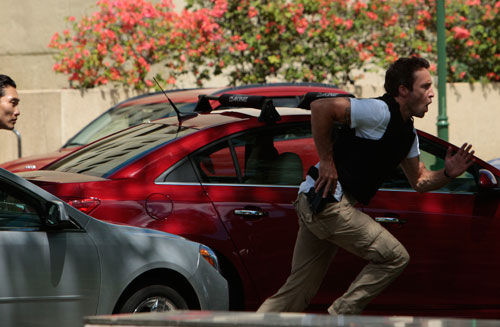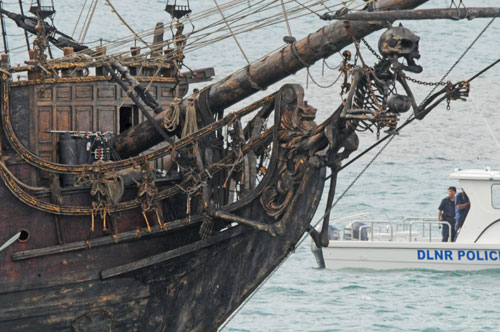Lights. Camera. Cash.

Alex O'Loughlin, who plays Steve McGarrett in CBS' new "Hawaii Five-0," chased the bad guys outside Restaurant Row during a shoot last month.

A ship from Disney's "Pirates of the Caribbean: On Stranger Tides" became a familiar sight as the movie was filmed at locations around Oahu.


No one seemed to notice the gunfire inside Pacific Rim Bank. Even when two dozen panicky people rushed out onto the plaza at Restaurant Row, heads barely turned.
But when Alex O’Loughlin, Daniel Dae Kim and Grace Park stepped up to save the day in this scene from the new "Hawaii Five-0" — each in a bulletproof vest, their handguns drawn and wearing fresh makeup — cell phone cameras took aim.
They’re the state’s newest heroes.
As fan favorites of the re-imagined police drama, the actors are helping to drive the state’s film and TV industry to a record-setting year, one that could see as much as $347 million in production spending, according to state estimates. That’s up more than 50 percent from the $229 million in 2007, the previous record year.
The state estimates the total economic impact of this year’s heavy production spending will be $539 million, as wages work their way through the community.
"This is a phenomenal year for production and for lots of reasons," said Georja Skinner, administrator for the state’s creative services division, which oversees the Hawaii Film Office. "I think all of it is converging in this very unique way. The tax incentive is stable, it works well and is a benefit. And there are productions coming in."
Don't miss out on what's happening!
Stay in touch with breaking news, as it happens, conveniently in your email inbox. It's FREE!
State tourism officials love it when productions put Hawaii front and center and "Hawaii Five-0" is definitely doing that, Skinner said. The hype promoting the show, weeks before its Sept. 20 network premiere, includes TV spots worth millions of dollars in free advertising.
WHEN TO WATCHThe new "Hawaii Five-O" will be shown on CBS at 9 p.m. Monday on the 42nd anni- More photos: |
"You just can’t argue with Hawaii being in everyone’s living room," Skinner said. "It not only keeps the production businesses afloat, it helps support the tourism message by not only having products that air this year but well into late 2011."
"Hawaii Five-0" is one of two new network series being shot in Hawaii — ABC’s medical drama "Off the Map" started shooting Aug. 30. And the state has already hosted eight feature film productions this year: Clint Eastwood’s "Hereafter"; the Bethany Hamilton biopic "Soul Surfer"; "The Descendants" with George Clooney; the locally written and produced "Get a Job"; "Uchu Senkan Yamato," a Japanese film; Adam Sandler’s "Just Go With It"; "Caesar: Rise of the Apes," which filmed for only a few days; and "Pirates of the Caribbean: On Stranger Tides," starring Johnny Depp.
In addition, "Battleship," from Universal Pictures, which published reports say will cost $200 million, began last week, and "Journey to the Center of the Earth 2," a big-budget production from New Line Cinema and Warner Bros., is in pre-production here even though it has not officially selected Hawaii as a location.
Add to that the final months of ABC’s "Lost," which spent hundreds of millions of dollars in a six-season run that ended in May, and 2010 could be a tough act to follow.
All of it fuels the industry here, from background extras to electricians, production coordinators to caterers, set builders to location scouts.
"For all of us, it’s an incredible gold rush," said Randy Spangler, a location manager who got his start in 1969 working on the original "Five-0." "Needless to say, we’re all ecstatic. We are working our butts off."
Spangler worked on "Lost" for all six seasons and when it wrapped this spring, he went to work on "Pirates." From there it was on to "Off the Map." In a business where a crew member can get laid off six times a year, that kind of consistency is great, he said.
"I always tell people that when you work in this industry you have to work like you are on unemployment all the time," he said. "If you are not working you are on unemployment and if you are working you have to save for unemployment."
Local production talent made up 40 percent of the crew employed by "Pirates of the Caribbean: On Stranger Tides" during its two-month shoot on Kauai and Oahu this summer.
"Hawaii has a hard-working pool of behind-the-scenes talent forged by years of experience, so it made sense for us to utilize as many local crew as possible," said Hollywood film and television mogul Jerry Bruckheimer, the film’s producer.
That also has been the experience at the CBS set of "Five-0," said one of the show’s executive producers, Peter Lenkov. He had never worked in Hawaii before.
"It’s a lot smoother than I ever imagined," he said. "You always expect when you go outside of L.A. you will face a lot of hurdles. But they have built great crews over time and are very production-friendly."
The number of productions has kept Kauai-based set photographer Mario Perez on a frequent-flier schedule. Perez shoots stills on movie and television sets and he estimates his workload has increased 45 percent over last year.
"In March I flew six times in one week and every other day I worked on a different show," he said. "I wish it was like this all the time. I wish next year we could count on as many productions as we had this year."
But it’s a fickle industry. Shows can get canceled and other filming locations can suddenly look more attractive. "Things can change in a heartbeat," Perez said. "My normal saying is you don’t know you are working until the first paycheck clears."
Leroy Jenkins, owner of Production Partners, a Honolulu-based logistics company for film and TV projects, said the work done in 2010 will pay dividends in the years to come.
"I think this is going to show Hawaii in a really good light in the future," he said. "Finally, Hawaii is on the map. I think we have shown L.A. and the rest of the industry that Hawaii is a great 12-month filming location."
There’s no single reason for the successful year. Big projects like "Pirates," which was expected to generate more than $85 million in direct and indirect spending in the islands, certainly helped. A typical network TV series works from a budget of $2 million to $2.5 million an episode, with two-thirds of that usually spent in Hawaii.
Many in the industry here cite a state tax incentive as a large contributing factor this year. Approved in 2006, the Act 88 refundable tax credit provides a 15 percent refund on Oahu and a 20 percent refund on the neighbor islands.
The tax credit gave rise to steady work, which in turn elevated the skills of production crews here, said Walea Constantinau, commissioner for the Honolulu Film Office. This year, the film and TV industry flexed its new-found muscles.
"I think a lot of people are looking at this year and realizing how economically meaningful this industry is to the islands," she said. "This year, more than ever, shows how many lives it touches, how it affects the economy."
But to keep the growth coming, the industry here will need to examine the amount of studio space it has. The state owns a single, 16,500-square-foot sound stage, at Diamond Head. It has been leased to ABC since the early years of "Lost" and will be used for "Off the Map."
Constantinau likens the situation to owning a delivery company with only one vehicle. When "The Descendants" filmed here, it set up shop in the empty CompUSA building on Ala Moana Boulevard. CBS had hoped to take over there, but wound up in an empty warehouse adjacent to the old Honolulu Advertiser building.
Studio space is as critical to the state’s reputation as are lush jungle locations. Every time Constantinau sees a big-box store go out of business, she sees it as a potential sound stage.
"If you want to develop as a production center you need to know what are the critical elements you need to address," Constantinau said. "So instead of only getting half the movie, you get the whole movie."
Back at the plaza outside the Pacific Rim Bank, the background extras — that is, the panicked customers — stood around after rushing out of the bank for the 10th time. Or was it the 11th? Even a short, simple scene can take hours to shoot.
For Kim Adams, the repetition was a blur, but she didn’t care. She was a background extra on ABC’s "Lost" and knows the routine.
"There’s a lot of work for actors in Hawaii," said Adams, the owner of a Kailua cleaning service. "It’s so exciting. It gives a lot of local people a chance to experience what it’s like to be in Hollywood but not have to be there."




